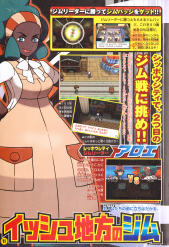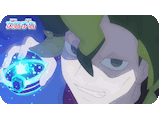
BW 014 - BW 016
The Aloe Change



Main
Old Updates Archive
Links
 |
Lists |
List of Pokémon
Pokémon World Atlas
List of Techniques
List
of Items
List of TV Episodes
 |
Guides |
Episode
Comparisons
Movies
& Specials Guide
CD Guide
DVD Guide
Voice
Actors Guide
Lyrics Archive
Manga Guide
Video Games
 |
Miscellaneous |
Humor
Pokémon Bashing
Features
Rants
Dogasu's
Backpack
| Episode Comparisons | Best Wishes!
When "A Night in the
Nacrene City Museum!"
aired on Cartoon Network on May 7th, 2011, fans noticed that a rather
elaborate edit had
taken place from the original TV-Tokyo airing. This same edit
occurred in the next two episodes, "The Battle
According to Lenora!" and "Rematch at the
Nacrene Gym!"
So what's going on here? Why would anyone find it necessary to edit over 100 different shots across three episodes to remove something as innocuous as an apron? And who did this edit in the first place?
What's so offensive about an apron?
This is very similar to the whole Rougela controversy, and not just because the group being stereotyped here are black people.
With Rougela, you have to remember that it was the combination of stereotypical attributes that led to people's outrage. It wasn't just the black skin or just the big red lips or just the way it wiggles its hips or just its "full figure," to quote Ms. Weatherford. Alone, those things wouldn't have raised an eyebrow. It's only when you combine all these into one package that you get what many consider to be a racist stereotype. Take away one aspect - the character's black skin, for instance - and the problem no longer exists.
The same sort of thing is happening with Aloe. Many people believed that she looked like the Mammy archetype, a racist stereotype different from the "overweight drag queen incarnation of Little Black Sambo" stereotype that Rougela resembled. Aloe, being a full figured (as far as we could tell from the earlier artwork) black woman with an apron, large hair, and a headband all combine to make the Gym Leader look like what many people consider to be a racist stereotype. Take one of these things away and the problem ceases to exist. Again, it's the combination of stereotypes that's the problem here.
Changing Aloe's skin color was probably rejected for fear that it would look like they were trying to whitewash the franchise, even though they kind of already did the reverse of that with Rapla in Pokémon Battle Revolution. Or maybe they felt like removing her apron was the least intrusive change they could have made? Whatever the reasoning, the apron was the aspect that was chosen to be removed for international audiences.
So why not just draw Aloe without the apron on in the first place? After all, this episode aired months after Sugimori updated his artwork, right?
Aloe was officially revealed to the public in the September 2010 issue of CoroCoro Comics that went on sale in August 2010. In this issue, she's drawn with her old design, and it's assumed that it was released without Game Freak realizing that there would be any sort of backlash.
Now we don't know how much feedback the company got that prompted them to make the change. Maybe fans complained and they changed the design before word could spread? Or maybe Nintendo of America gave Nintendo of Japan a panicked phone call and told them that there was no way they could get away with releasing a character that looked like that outside Japan? Or maybe Game Freak did it themselves, changing their minds after thinking things over? Whatever the case may be, the old stock artwork you see above was removed from the franchise's official Japanese site and replaced with a new version by October of that same year. In this updated image, Aloe has her apron slung over her shoulder and she's striking a slightly different pose.
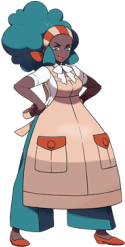
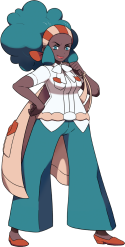
Now, let's look at the TV show. An episode of the animated series takes about six months or so to make, start to finish. We actually know for a fact that the character model sheets for the episode "The Shippou Gym Battle! Satoshi vs. the Gym Leader Aloe!!" were being worked on as far back as June 17th, 2010. I think it's safe to assume that the other two episodes were being worked on at around the same time.
By the time the general public saw its first glimpse of Aloe, the episodes in question were already two months into production. And by the time the official artwork was changed, they were already two thirds done. Animation work would have already started by that point, making it too late to go in and make any changes as major as a character redesign. The animators had a deadline to meet, after all, so they had to make the decision to finish the episode the way they started and then go back and "fix" it later.
Now it's possible that the animators started work on the edited versions before the episodes premiered on TV-Tokyo but weren't able to finish them by the time they aired in December / January. But that's just my speculation.
By the time the thirty-sixth episode aired ("The Fossil Revival! Archaeos, the Ominous Ancient Bird!!"), the TV staff switched over to the new version. Compared to how long it took them to adopt Rougela's updated look, this is quite fast.
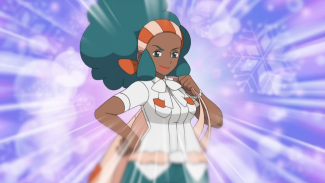
The two manga series that have featured the character so far has drawn her with her new design, but that's mainly due to the fact that manga takes a lot less time to make than an episode of a TV series does. A change in character design can happen much more quickly in manga than it can in the TV series.
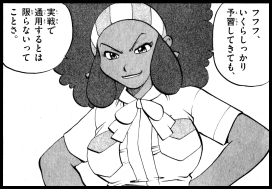
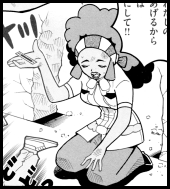
As of this writing, the actual video games themselves and the TV series are the only media in Japan to feature Aloe with her older design. In the US, the video games are the only media to use her old design.
So who did this edit, anyway? The Japanese animators? The English dubbers?
There is no doubt in my mind that this was an edit performed by the original animators over in Japan. A mere look at the edit should reveal why.
There is absolutely no way a company like The Pokémon Company International would have the resources to be able to pull off anything like this. This isn't meant to be a slight against them or anything; it's the simple truth. TPCI is not an animation studio. They simply don't have the means to do something like this.
Now the company can, and has, done visual edits before. But the type of thing that was done to Aloe is in a whole different league from changing text on a static image. All they have to do with the latter is erase the original text by clone brushing the background and then replacing it with their own, like they did in the first episode of Diamond & Pearl, "Following a Maiden Voyage!"
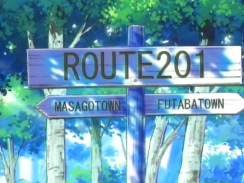
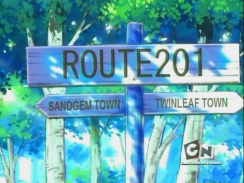
With Aloe's apron, it's a different story. We tend to say that the animators "erased Aloe's apron," but that's actually quite a misleading way of phrasing it. It's not like the animators took a rubber eraser and went to work on these drawings until a white shirt'd blue pants'd Aloe emerged on the screen. No, what they ended up doing was redraw her form the neck down. A lot of the show is done on computers now, so what they most likely did was remove whatever layer contained Aloe's old body and replace it with a new drawing of Aloe's body. It's a lot like editing layers in Photoshop, only much more time consuming since they'd have to edit about 30 frames for every one second of animation.
Assuming that information in this interview up on Pokébeach is still current, The Pokémon Company International is sent copies of the completed version of the episodes without any of the computer files used in the episode's production. OLM wouldn't have any reason to send in the first place, y'know? So without the raw animation tools used to create the episode in the first place, TPCI wouldn't have been able to edit Aloe's apron away.
Japanese Home Video Release
When it comes to the edits in "The Nomose Great Marsh's Gureggru Festival!?", I was able to prove that the character re-design in that episode were done by the Japanese animators thanks to the fact that the new version also appeared on the Japanese rental DVDs. The original broadcast version will probably never see an official release, ever.
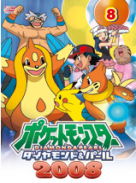
With these Best Wishes episodes, however, the unedited version that aired on TV-Tokyo is what's present on the DVD. The newly animated de-apron'd version is nowhere to be found.

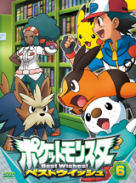
My guess is that pretty much nobody in Japan knows or cares about any racist undertones present in Aloe's design. For them, she's just a black lady with an apron. With the Gureggru episode, the potential legal issues that would have led to the edits in that episode in the first place would have been on the Japan side of things, making a release of the litigious version in that country an unwise move. An edited version of the Aloe episodes, on the other hand, wouldn't make as much sense since the only people who seem to have any problems with it are people outside Japan.
I guess it would be fair to say that the edits that took place in this episode are like the extra scenes in Pokémon 4Ever, or the extra scenes animated for the show's fourth season opening theme, "Born to Be a Winner." They were done by the same Japanese animators who work on the TV show but are only used for the international versions of the show. The same thing seems to apply here: Aloe's apron was edited away by the Japanese animators but was only used for versions of the show outside of Japan.
Final Thoughts
In the grand scheme of things, this edit is no more intrusive than the edit to Rougela's skin color. It sucks that the animators basically had to create two versions of these three episodes, especially given all the other episodes that required retooling during this time period, but at least their work is done. Hopefully, there won't be any more characters who require re-designs in order to make them acceptable to foreign markets and everyone will be able to enjoy the same characters on both sides of the Pacific.
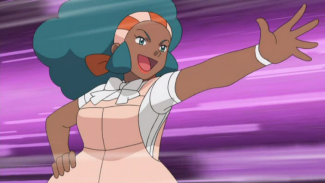 |
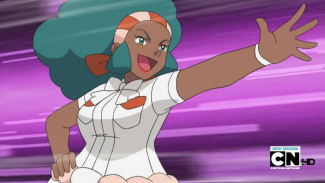 |
So what's going on here? Why would anyone find it necessary to edit over 100 different shots across three episodes to remove something as innocuous as an apron? And who did this edit in the first place?
What's so offensive about an apron?
This is very similar to the whole Rougela controversy, and not just because the group being stereotyped here are black people.
With Rougela, you have to remember that it was the combination of stereotypical attributes that led to people's outrage. It wasn't just the black skin or just the big red lips or just the way it wiggles its hips or just its "full figure," to quote Ms. Weatherford. Alone, those things wouldn't have raised an eyebrow. It's only when you combine all these into one package that you get what many consider to be a racist stereotype. Take away one aspect - the character's black skin, for instance - and the problem no longer exists.
The same sort of thing is happening with Aloe. Many people believed that she looked like the Mammy archetype, a racist stereotype different from the "overweight drag queen incarnation of Little Black Sambo" stereotype that Rougela resembled. Aloe, being a full figured (as far as we could tell from the earlier artwork) black woman with an apron, large hair, and a headband all combine to make the Gym Leader look like what many people consider to be a racist stereotype. Take one of these things away and the problem ceases to exist. Again, it's the combination of stereotypes that's the problem here.
Changing Aloe's skin color was probably rejected for fear that it would look like they were trying to whitewash the franchise, even though they kind of already did the reverse of that with Rapla in Pokémon Battle Revolution. Or maybe they felt like removing her apron was the least intrusive change they could have made? Whatever the reasoning, the apron was the aspect that was chosen to be removed for international audiences.
So why not just draw Aloe without the apron on in the first place? After all, this episode aired months after Sugimori updated his artwork, right?
Aloe was officially revealed to the public in the September 2010 issue of CoroCoro Comics that went on sale in August 2010. In this issue, she's drawn with her old design, and it's assumed that it was released without Game Freak realizing that there would be any sort of backlash.
Now we don't know how much feedback the company got that prompted them to make the change. Maybe fans complained and they changed the design before word could spread? Or maybe Nintendo of America gave Nintendo of Japan a panicked phone call and told them that there was no way they could get away with releasing a character that looked like that outside Japan? Or maybe Game Freak did it themselves, changing their minds after thinking things over? Whatever the case may be, the old stock artwork you see above was removed from the franchise's official Japanese site and replaced with a new version by October of that same year. In this updated image, Aloe has her apron slung over her shoulder and she's striking a slightly different pose.


Now, let's look at the TV show. An episode of the animated series takes about six months or so to make, start to finish. We actually know for a fact that the character model sheets for the episode "The Shippou Gym Battle! Satoshi vs. the Gym Leader Aloe!!" were being worked on as far back as June 17th, 2010. I think it's safe to assume that the other two episodes were being worked on at around the same time.
By the time the general public saw its first glimpse of Aloe, the episodes in question were already two months into production. And by the time the official artwork was changed, they were already two thirds done. Animation work would have already started by that point, making it too late to go in and make any changes as major as a character redesign. The animators had a deadline to meet, after all, so they had to make the decision to finish the episode the way they started and then go back and "fix" it later.
Now it's possible that the animators started work on the edited versions before the episodes premiered on TV-Tokyo but weren't able to finish them by the time they aired in December / January. But that's just my speculation.
By the time the thirty-sixth episode aired ("The Fossil Revival! Archaeos, the Ominous Ancient Bird!!"), the TV staff switched over to the new version. Compared to how long it took them to adopt Rougela's updated look, this is quite fast.

The two manga series that have featured the character so far has drawn her with her new design, but that's mainly due to the fact that manga takes a lot less time to make than an episode of a TV series does. A change in character design can happen much more quickly in manga than it can in the TV series.


As of this writing, the actual video games themselves and the TV series are the only media in Japan to feature Aloe with her older design. In the US, the video games are the only media to use her old design.
So who did this edit, anyway? The Japanese animators? The English dubbers?
There is no doubt in my mind that this was an edit performed by the original animators over in Japan. A mere look at the edit should reveal why.
There is absolutely no way a company like The Pokémon Company International would have the resources to be able to pull off anything like this. This isn't meant to be a slight against them or anything; it's the simple truth. TPCI is not an animation studio. They simply don't have the means to do something like this.
Now the company can, and has, done visual edits before. But the type of thing that was done to Aloe is in a whole different league from changing text on a static image. All they have to do with the latter is erase the original text by clone brushing the background and then replacing it with their own, like they did in the first episode of Diamond & Pearl, "Following a Maiden Voyage!"


With Aloe's apron, it's a different story. We tend to say that the animators "erased Aloe's apron," but that's actually quite a misleading way of phrasing it. It's not like the animators took a rubber eraser and went to work on these drawings until a white shirt'd blue pants'd Aloe emerged on the screen. No, what they ended up doing was redraw her form the neck down. A lot of the show is done on computers now, so what they most likely did was remove whatever layer contained Aloe's old body and replace it with a new drawing of Aloe's body. It's a lot like editing layers in Photoshop, only much more time consuming since they'd have to edit about 30 frames for every one second of animation.
Assuming that information in this interview up on Pokébeach is still current, The Pokémon Company International is sent copies of the completed version of the episodes without any of the computer files used in the episode's production. OLM wouldn't have any reason to send in the first place, y'know? So without the raw animation tools used to create the episode in the first place, TPCI wouldn't have been able to edit Aloe's apron away.
Japanese Home Video Release
When it comes to the edits in "The Nomose Great Marsh's Gureggru Festival!?", I was able to prove that the character re-design in that episode were done by the Japanese animators thanks to the fact that the new version also appeared on the Japanese rental DVDs. The original broadcast version will probably never see an official release, ever.

With these Best Wishes episodes, however, the unedited version that aired on TV-Tokyo is what's present on the DVD. The newly animated de-apron'd version is nowhere to be found.


My guess is that pretty much nobody in Japan knows or cares about any racist undertones present in Aloe's design. For them, she's just a black lady with an apron. With the Gureggru episode, the potential legal issues that would have led to the edits in that episode in the first place would have been on the Japan side of things, making a release of the litigious version in that country an unwise move. An edited version of the Aloe episodes, on the other hand, wouldn't make as much sense since the only people who seem to have any problems with it are people outside Japan.
I guess it would be fair to say that the edits that took place in this episode are like the extra scenes in Pokémon 4Ever, or the extra scenes animated for the show's fourth season opening theme, "Born to Be a Winner." They were done by the same Japanese animators who work on the TV show but are only used for the international versions of the show. The same thing seems to apply here: Aloe's apron was edited away by the Japanese animators but was only used for versions of the show outside of Japan.
Final Thoughts
In the grand scheme of things, this edit is no more intrusive than the edit to Rougela's skin color. It sucks that the animators basically had to create two versions of these three episodes, especially given all the other episodes that required retooling during this time period, but at least their work is done. Hopefully, there won't be any more characters who require re-designs in order to make them acceptable to foreign markets and everyone will be able to enjoy the same characters on both sides of the Pacific.
This page was last updated
on August 25th, 2011
Found an error or omission? Please help me keep this page current and error-free by e-mailing me with a description of the issue.


